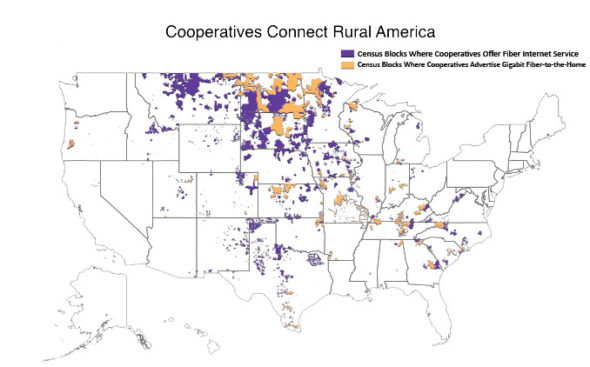 Telecom and electric cooperatives are playing an important role in bringing high-speed broadband to rural America, according to a new report from the Community Broadband Networks Initiative at the Institute for Local Self-Reliance (ILSR). Using FCC data, researchers identified 87 cooperative gigabit deployments as of December 2016.
Telecom and electric cooperatives are playing an important role in bringing high-speed broadband to rural America, according to a new report from the Community Broadband Networks Initiative at the Institute for Local Self-Reliance (ILSR). Using FCC data, researchers identified 87 cooperative gigabit deployments as of December 2016.
The majority of the nation’s 260 telecom cooperatives have deployed fiber-to-the-home, the report titled “Cooperatives Fiberize Rural America,” noted.
About 60 of the nation’s 900 electric cooperatives have deployed fiber, and that number is growing fast.
“Cooperatives have quietly proved that they can build fiber-to-the-home networks that are capable of speeds of more than 1 gigabit per second,” the report authors said.
Cooperative Gigabit Deployments
A map created by ILSR plots cooperative gigabit deployments and FTTH deployments by census tract as of December 2016. Only cooperatives advertising gigabit service were counted as gigabit deployments. As the authors note, some deployments may be capable of supporting gigabit speeds but were not counted as gigabit deployments because the provider does not offer gigabit service at this time.

Cooperatives are well suited to bringing high-speed broadband to rural areas that may not be of interest to private companies because of high deployment costs, ILSR argues. Some cooperatives have obtained funding to cover some project costs through the Connect America Fund, the broadband stimulus programs of the early part of this decade or the Rural Utilities Service. But other projects, such as deployments made by Co-Mo Electric Cooperative, were self-financed.
And while some cooperatives have been around for decades, some new ones have been formed for the express purpose of bringing broadband to rural areas. The authors point to the examples of Allband Communications Cooperative in Michigan and RS Fiber in Minnesota that were formed in the 1990s or later.
The authors make several policy recommendations aimed at encouraging cooperative fiber and cooperative gigabit deployments. These include:
- Design funding programs with cooperatives in mind by, for example, recognizing that letters of credit from the largest banks may be difficult for smaller cooperatives to obtain
- Encourage cooperatives by removing barriers that prevent them from applying for federal grants and encouraging partnerships between municipal networks and neighboring towns
- Encourage community involvement with local cooperatives
- Make it clear that rural broadband serves important economic needs and is about more than entertainment
Image courtesy of flickr user María de los Angeles Quiroz.

